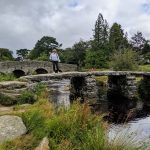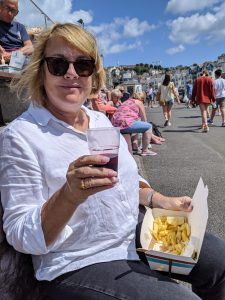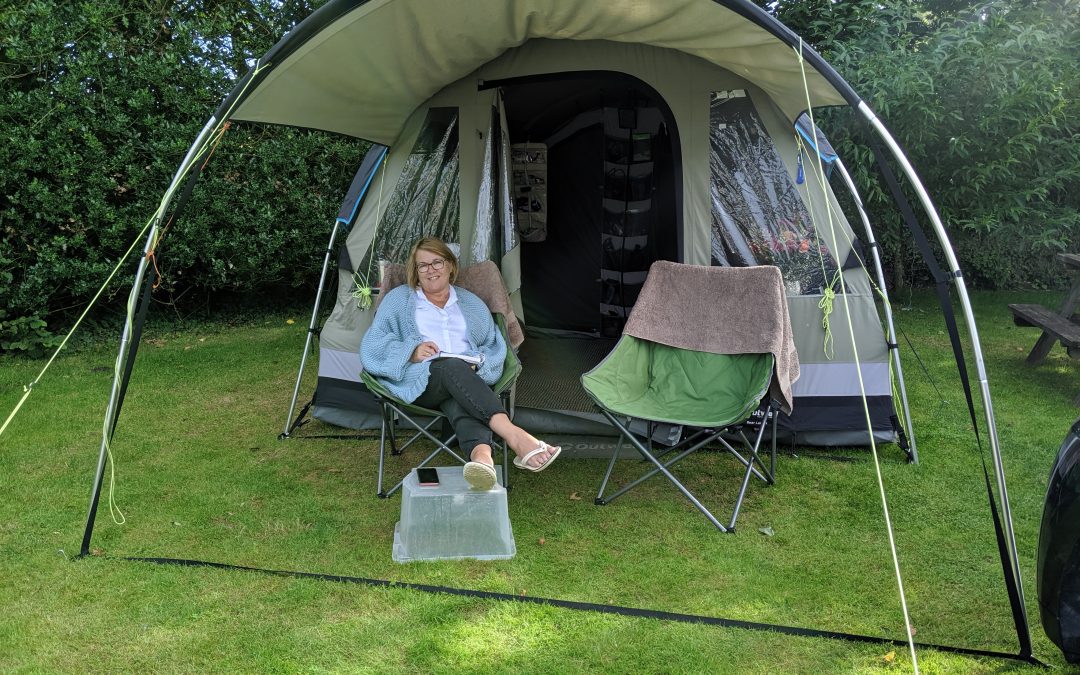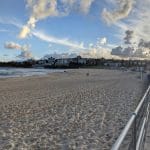Camping then….

Le Paradis campsite
preferred a level of comfort to any sort of rough camping so our last ‘van, replacing the one written-off on our way home from the Dordogne one year, was equipped with a shower, flush toilet, fridge, central heating for winter camping, fly screens, hot and cold pumped water, TV and a large awning to shelter from the sun or rain. Camping so suited our young family. Fresh air, a new exciting environment, new children to meet and play with, a different bed and our full attention all day. Wonderful happy family days when they were safe and free to explore the campsite on their own and meet up and play with other young children. Very often their new friends couldn’t speak English but that never seemed to matter. We’d often see them running around in a large group together, excitedly playing a role-play game one of them had imagined or dashing in and around their new friends’ or our camp areas. For a few years we’d go back to the same Dordogne site and meet up with some of the same people we’d met there the year before, and we’re still in touch with a couple

Le Paradis childrens show
of Belgian Dordogne fellow campers who remain friends today. It would take a full two days to drive there but we’d notice the weather getting warmer as we drove south and we’d stay for two or even three glorious weeks. The girls couldn’t wait for breakfast and other morning chores to be over before running off to play in their new gangs whilst we’d relax, enjoy a swim in the site pool or pass the time with other camping parents whilst sharing keeping a lazy ear and eye out for them. The highlight of each week would be the children’s ‘show’, put on in the bar by the camp kids club, when each child had a ‘spot’ or took part in a group song or dance in front of a packed audience of anxious and proud parents.
.
…and now
.
Brixham harbour

Postbridge Clapper Bridge
Our drive there was pretty enough, including a photo stop at Postbridge to see the 13th Century stone clapper bridge, built to enable packhorses to get to the stannary town of Tavistock. We stopped again for coffee at the old police station cafe near the forbidding Dartmoor Prison in Princetown then drove on to Brixham, a town which attracts and welcomes its visitors, unlike one or two other Devon seaside destinations we could mention, and we quickly found convenient car parking a short walk from the harbour. We walked through throngs of other tourists enjoying the sunshine and the boats, excited children leaning over the harbour edge with lines and buckets, letting out squeals of delight when a crab came up on their line and was plopped into their buckets. There’s a full-size replica of Sir Francis Drake’s Golden Hind ship (more about this later) permanently moored in the harbour but we’d looked over it in April so we didn’t stop this time.
 On to the busy Rockfish restaurant, mid-service, eat-in or take-out. The Awards recognise customer service as well as the food quality and despite the large number of other queuing customers I was quickly approached and shown what fish they had available. I ordered a standard cod and chips, twice, plus two small glasses of wine, homemade tartare sauce and mushy peas which was quickly served and I took it out to the harbour where we thoroughly enjoyed our delicious lunch in the sun.
On to the busy Rockfish restaurant, mid-service, eat-in or take-out. The Awards recognise customer service as well as the food quality and despite the large number of other queuing customers I was quickly approached and shown what fish they had available. I ordered a standard cod and chips, twice, plus two small glasses of wine, homemade tartare sauce and mushy peas which was quickly served and I took it out to the harbour where we thoroughly enjoyed our delicious lunch in the sun. Okehampton Show
 competition classes, horse displays, birds of prey, vintage vehicles, children’s rides, ferret racing, a local beers and ciders tent, food stalls, hundreds of country stalls and thousands of visitors. The weather was very kind. Despite grey clouds moodily passing over the surrounding Dartmoor fells the day was warm and mostly sunny so we were all very lucky to have such a lovely show day just ahead of the now-forecast four-day mini-storm which arrives tonight. We bought new beds for the dogs from one stall and at another I finally bought myself a proper fishing jacket. Not only is the jacket comfortable but it immediately made me feel part of the country sports set too so the fish had better look out next time I get my rod out. It was a lovely day mixing with the local farming families and the real country set.
competition classes, horse displays, birds of prey, vintage vehicles, children’s rides, ferret racing, a local beers and ciders tent, food stalls, hundreds of country stalls and thousands of visitors. The weather was very kind. Despite grey clouds moodily passing over the surrounding Dartmoor fells the day was warm and mostly sunny so we were all very lucky to have such a lovely show day just ahead of the now-forecast four-day mini-storm which arrives tonight. We bought new beds for the dogs from one stall and at another I finally bought myself a proper fishing jacket. Not only is the jacket comfortable but it immediately made me feel part of the country sports set too so the fish had better look out next time I get my rod out. It was a lovely day mixing with the local farming families and the real country set..
Buckland Abbey
 Paula’s family tree shows a potential first cousin link to Francis Drake, the famous Golden Hind (there you go) circumnavigator sea captain, privateer, naval commander, slave trader, explorer, knight of the realm and Spanish Armada vanquisher. Paula’s currently working to prove the link, as best she can back to 1563, and if she does I will duly curtsey and write a specific blog post about it. So we went to visit nearby Buckland Abbey, Sir Francis’ home now in the care of the National Trust, to find out more about him and his family, and we found it to be one of the most interesting NT houses we’ve ever visited. First, there was the National Gallery portrait of Drake himself to see, on loan as part of the Gallery’s ‘Coming Home’ project. “The painting was created shortly after Drake came home from his circumnavigation of the globe. In 1581 following his return, his life entirely changed. His voyage made him famous as well as fabulously wealthy. He was knighted by Elizabeth I, and was able to purchase Buckland Abbey – a country home that befitted his new found status. He then became mayor of Plymouth and an MP. He was even granted his own Coat of Arms with a motto that reminded him of his yeomanry birth – sic parvis magna – from small beginnings, great things.”
Paula’s family tree shows a potential first cousin link to Francis Drake, the famous Golden Hind (there you go) circumnavigator sea captain, privateer, naval commander, slave trader, explorer, knight of the realm and Spanish Armada vanquisher. Paula’s currently working to prove the link, as best she can back to 1563, and if she does I will duly curtsey and write a specific blog post about it. So we went to visit nearby Buckland Abbey, Sir Francis’ home now in the care of the National Trust, to find out more about him and his family, and we found it to be one of the most interesting NT houses we’ve ever visited. First, there was the National Gallery portrait of Drake himself to see, on loan as part of the Gallery’s ‘Coming Home’ project. “The painting was created shortly after Drake came home from his circumnavigation of the globe. In 1581 following his return, his life entirely changed. His voyage made him famous as well as fabulously wealthy. He was knighted by Elizabeth I, and was able to purchase Buckland Abbey – a country home that befitted his new found status. He then became mayor of Plymouth and an MP. He was even granted his own Coat of Arms with a motto that reminded him of his yeomanry birth – sic parvis magna – from small beginnings, great things.” .
Drake’s amazing life
.
Drake’s Leat
The bill was passed to a Select Committee chaired by Sir Francis Drake for consideration. Drake proposed an additional clause stating that mills could be erected and operated on the banks of the leat. It gained royal assent and was passed as an Act in 1585 “For the Preservation of the Haven of Plymouth”. Due to lack of funding caused by the war with Spain and the Armada construction was not started until 1590 and completed in 1591. The construction of the leat was by means of a simple ditch and bank which measured approximately six feet at its widest and was approximately two feet deep. Its course was deliberately meandering and gently sloping so that the water would not flow too fast and erode the banks. It was estimated that it took some thirty five men just over four months to complete the construction. Drake took part in the ceremonial turning of the first sod in December 1590. On 24 April 1591, the supply of water first flowed to Plymouth and the leat was blessed by the rector of Meavy. A legend records that at its opening Drake rode a white horse ahead of the water all the way to Plymouth.
.
Drake was paid £200 for the work plus another £100 for compensation to any landowners whose property the course of the leat would have to pass through. In the event he paid out only £100 for construction and £60 for compensation making a tidy £140 profit. The mill, into which the leat flowed, was leased by Drake as were all six of the new mills built in the same year.
.
On completion of the leat it was obvious that little heed had been paid to the original clauses as the leat did not flow to the naval victualling yard at Lambhay until 1645; it was of no use for fire fighting as it avoided the built up areas of the city; it never went near Sutton Harbour, entering the sea at Millbay instead; and finally no arrangements for supplying irrigation were ever made with the taking of water from the lease being made illegal. The primary purpose was to enable Drake to capitalise on his milling operations. Some of the excess water was made available to the public after it had driven the mill wheels but by 1600 only 30 homes had been connected. The canal, ‘Drake’s Leat’, eventually supplied Plymouth with fresh water for centuries. (Wikipedia)
.
Spanish Armada preemptive strike
Drake’s death
A remarkable life, not too dissimilar to Paula’s own, of course. Well, she does like boat trips.






